Exercise from P BAHADUR CHEMISTRY (HINGLISH) GASEOUS STATE for Class 11
| Class 11 | CHEMISTRY |
| Chapter | GASEOUS STATE |
| P BAHADUR CHEMISTRY (HINGLISH) | Exercise |
| Medium | English |
| Academic Year | 2023-2024 |
Question 6
A desiccator of internal volume one litre containing N2 at 1 atm is partially evacuated to final pressure of 78mm of Hg while T remains constant What is the volume of gas at this stage ?
(b) A lungful of air (3.55cm3) is exhaled into a machine that measures lung capcity if the air is exhaled from lungs at a pressure of 1.08 atm at 37∘C but the machine is a ambient conditions of 0.958 atm and 23∘C what is the volume of air measured by the machine ? .View SolutionQuestion 20
A closed container of volume 0.02m3contains a mixture of neon and argon gases, at a temperature of 27∘C and pressure of 1×105Nm−2. The total mass of the mixture is 28g. If the molar masses of neon and argon are 20and40gmol−1 respectively, find the masses of the individual gasses in the container assuming them to be ideal (Universal gas constant R=8.314J/mol−K).View SolutionQuestion 22
A vessel contains 14g of H2 and 96g of O2 at STP Calculate
(a) The volume of vessel
(b) the pressure in the vessel when chemical reaction is induced in the vessel by passing electric spark till one of the gas is consumed The temperature brought back to 273K Neglect the volume of water formed .View SolutionQuestion 26
A student forgot to add the reaction mixture to the round bottomed open flask at 27∘C and put it one the flame After a lapse of time he realized his mistake using a pyrometer he found the temperature of the flask was 477∘C What fraction of air would have been expelled out ? .View SolutionQuestion 29
A ballon blown up with 1 mole of gas has a volume of 480mL at 5∘C The balloon is filled to (7/8) th of its maximum capacity Suggest
(a) Will the balloon burst at 30∘C
(b) The minimum temperature at which it will burst
(c ) The pressure of gas inside the balloon at 5∘C
(d) The pressure of gas when balloon bursts .View SolutionQuestion 30
Volume of a tyre 10 litre when inflated The tyre is inflated to a pressure of 3atm at 17∘C with air Due to driving the temperature of tyre increases to 47∘C
(a) What would be the pressure at this temperature
(b) How many litre of air measured at 47∘C and pressure of 1 atm should be let out to restore the tyre of 3atm at 47∘C ? .View SolutionQuestion 31
A long rectangular box is filled with CI2 (at wt 35.45) which is known to contain only CI35 and CI37 if the box could be divided by a partition and the two tpye of chlorine molecules put into the two compartments respectively calculate where should partition be madel if the pressure on both sides are to be equal Is this pressure the same as original pressure ? .View SolutionQuestion 34
The apparatus shown consists of three bulbs connected by stop cocks What is the pressure inside the system when stop cocks are opened ? Assume that the lines connecting the bulbs have zero volume and that the temperature remains constant Assume ideal nature for gases
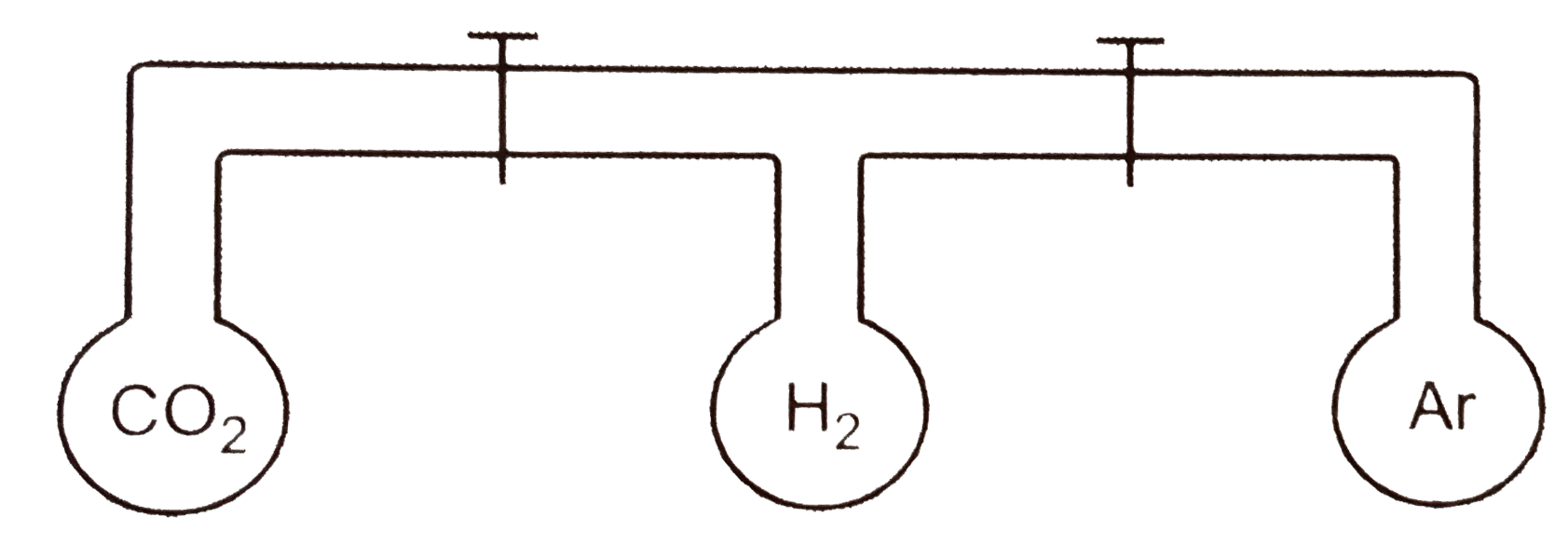
P=2.13atmP=0.861atmP=1.15atmV=1.50litreV=1.0litreV==2.0litre .View SolutionQuestion 37
Relative humidity id defind as the ration of partial pressure of water in air at a given temperature to the vapour pressure of water at that that temperature Calculate the mass of water per litre air at
(a) 20∘C and 45% relative humidity
(b) 0∘C and 95% relative humidity
(c ) Discuss wether temperature or relative humidity has the greater effect on the mass of water vapour in air Given P∘H2O=17.5 torr at 20∘C and 4.58 torr 0∘C .View SolutionQuestion 40
The pressure in a bulb dropped from 2000 to 1500mmHg in 47min when the contained oxygen leaked through a small hole. The bulb was then evacuated. A mixture of oxygen and another gas of molecular weight 79 in the molar ratio of 1:1 at a total pressure of 4000mm of mercury was introduced. Find the molar ratio of the two gases remaining in the bulb after a period of 74min.View SolutionQuestion 43
A mixture of 0.5 mole of CO and 0.5 mole of CO2 is taken in a vessel and allowed to effuse out through a pinhole into another vessel which has vacuum If a total of A mole has effused out in time t show that M1A+M2(1−A)=36 where M1 and M2 are mean molar masses of the mixture that has effused out and the mixture still remaining in vessel respectively . View SolutionQuestion 44
The pressure in a bulb dropped from 2000 to 1500mmHg in 47min when the contained oxygen leaked through a small hole. The bulb was then evacuated. A mixture of oxygen and another gas of molecular weight 79 in the molar ratio of 1:1 at a total pressure of 4000mm of mercury was introduced. Find the molar ratio of the two gases remaining in the bulb after a period of 74min.View SolutionQuestion 69
A manometer is connected to a gas containing bulb. The open arm reads 43.7cm whereas the arm connected to the bulb reads 15.6cm. If the barometric pressure is 743mm mercury , calculate the pressure of the gas in bar?
Strategy : The pressure of the gas inside the bulb is greater than the external atmospheric pressure because the height of mercury column in the left arm is less than in the right arm.Therefore ,
pgas(in cm)=patom(in cm)+hcmView SolutionQuestion 70
A mixture of N2NO and NO2 was analysed by selctive absorption of the oxides of nitrogen The initial volume of the mixture was 2.74cm3 After treatment with water which absorbed the NO2 the volume was 2.02cm3 A ferrous sulphate solution was then shaken with the residual gaseas after which the volume was 0.25cm3 All volumes were measured at same P and T neglecting water vapour what was the volume % of each gas in the origional mixture ? .View SolutionQuestion 71
A mixture of hydrogen and oxygen at one bar pressure contains 20% by weight of hydrogen Calculate the partial pressure of hybrogen (b) A sample of gaseous arsine (AsH3) in a 500ML flask at 300 torr and 223 K is heated to 473 K at which AsH3 decomposes to soild arsenic ahd H2 fas The flask is then cooled to 273K at which the pressure in flask is 508 torr Calculate the % of AsH3 decomposed .View SolutionQuestion 74
A bottle contains 1.0 mole He (g) and a second bottle contains 1.0 mole Ar (g) at the same temperature At this temperature the root mean square speed of He is 1477ms−1 and that of Ar is 467ms−1 What is the ration of the number of He atoms in the first bottle to the number of Ar atoms in the second bottle having these speeds ? Assume that both gases behave ideally .View SolutionQuestion 79
An LPG cylinder weighs 14.8kg when empty. When full it weighs 29.0kg and the weight of the full cylinder reduces to 23.2kg. Find out the volume of the gas in cubic metres used up at the normal usage conditions and the final pressure inside the cylinder. Assume LPG to be n-butane with normal boiling point of 0∘C.View SolutionQuestion 84
At room temperature, the following reaction proceeds nearly to completion:
2NO+O2→2NO2→N2O4
The dimer, N2O4, solidfies at 262K. A 250mL flask and a 100mL flask are separated by a stopcock. At 300K, the nitric oxide in the larger flask exerts a pressure of 1.053atm and the smaller one contains oxygen at 0.789atm. The gase are mixed by opening the stopcock and after the end of the reaction the flasks are cooled to 220K. Neglecting the vapour pressure of the dimer, find out the pressure and composition of the gas remaining at 220K. (Assume the gases to behave ideally)View SolutionQuestion 88
The composition of the equilibrium mixture (Cl2 2Cl) , which is attained at 1200∘C, is determined by measuring the rate of effusion through a pin hole. It is observed that a 1.80mmHg pressure, the mixture effuses 1.16× as fact as krypton effuses under the same conditions. Calculate the fraction of chlorine molecules dissociated into atoms (atomic weight of Kr is 84).View Solution
2Cl) , which is attained at 1200∘C, is determined by measuring the rate of effusion through a pin hole. It is observed that a 1.80mmHg pressure, the mixture effuses 1.16× as fact as krypton effuses under the same conditions. Calculate the fraction of chlorine molecules dissociated into atoms (atomic weight of Kr is 84).View SolutionQuestion 89
A mixture containing 1.12 litre D2 and 2.24 liter of H2 at NTP is taken inside a bulb connected to another bulb through a stop cock with a small opening The second bulb is fully evacuated The stop cock is opened for a crtian time and then closed The first bulb is now found to contain 0.10g of D2 Determine the % by weight of the gases in second bulb
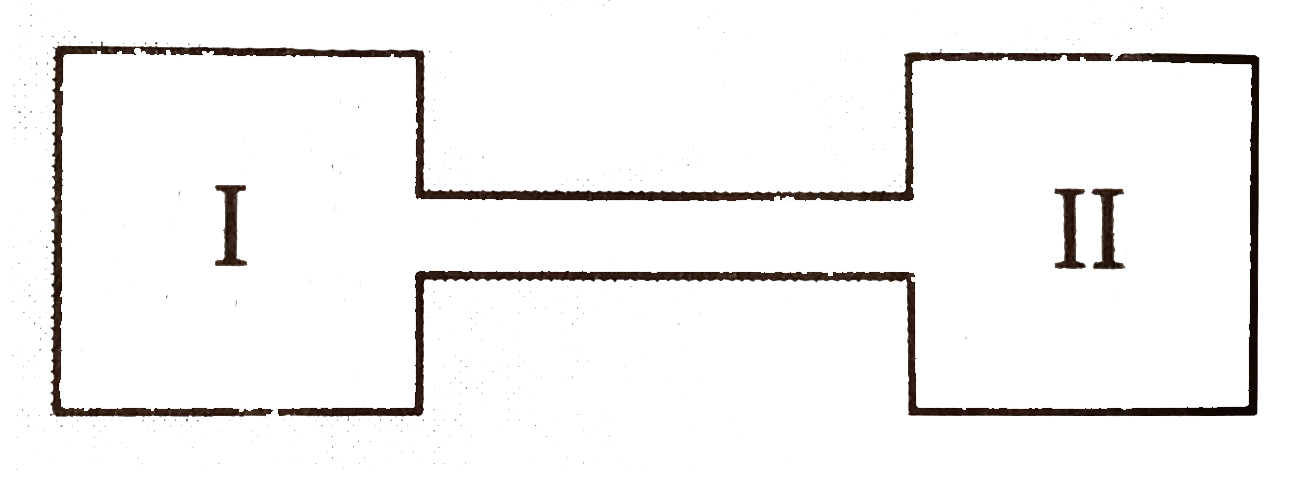 .View Solution
.View SolutionQuestion 90
At 27∘C, hydrogen is leaked through a tiny hole into a vessel for 20min. Another unknown gas at the same temperature and pressure as that of hydrogen is leaked through the same hole for 20min. After the effusion of the gases, the mixture exerts a pressure of 6atm. The hydrogen content of the mixture is 0.7mol. If the volume of the container is 3L, what is the molecular weight of the unknown gas?View SolutionQuestion 92
A gas bulb of 1L capacity contains 2.0×1011 molecules of nitrogen exerting a pressure of 7.57×103Nm−2. Calculate the root mean square (rms) speed and the temperature of the gas molecules. If the ratio of the most probable speed to the root mean square is 0.82, calculate the most probable speed for these molecules at this temperature.View SolutionQuestion 96
The density of the vapour of a substance at 1atm pressure and 500K is 0.36kgm−3. The vapour effuses through a small hole at a rate of 1.33 times faster than oxygen under the same condition.
(a) Determine (i) molecular weight, (ii) molar volume (iii) compression factor(Z) of the vapour, and (iv) which forces among the gas molecules are dominating, the attractive or the repulsive?
(b) If the vapour behaves ideally at 1000K, determine the average translational kinetic energy of a molecule.View SolutionQuestion 128
The circulation of blood in human body supplies O2 and releases CO2 The concentration of O2 and CO2 is variable but on the average 100mL blood contains 0.02g of O2 and 0.08g of CO2 Calcultate the volume of O2 and CO2 at 1 atm and body temperature 37∘C assuming 10 llitre blood in human body .View SolutionQuestion 247
A compound exists in the gaseous phase both as monomer (A) and dimer (A2) The mol wt of A is 48 In an experiment 96g of compound was confined in a container of volume 33.6 litre and heated to 273∘C Calulate the pressure developed if the compound exists as dimer to the extent of 50% by weight under samae these conditions .View SolutionQuestion 252
The Graham's law states that ''at constant pressure and temperature the rate of diffusion or effusion of a gas is inversely proportional to the squar root of its density Rate of diffusion ∝1√d
If r1 and r2 represent the rates of diffusion of two gases and d1 and d2 are their respective densities, then
r1r2=√d2d1
r1r2=√M2M1×P1P2
V1×t2V2×t1=√d2d1=√M2M1
V∝n (where n is no of moles)
V1∝n1 and V2∝n2
The time taken for a certain volume of gas X to diffuse through a small hole is 2 minutes It takes 5.65 minutes for oxygen to diffuse under the simillar conditions The molecular weight of X is .View SolutionQuestion 259
The behaviour of gases has been experessed in terms of various gas laws obtained experimentally Boyle s law Charles law Pressure temperature law Dalton s law of partial pressure Graham's law of diffusion and Avogadro's hypothesis Later on Maxwell derived Kinetic equation PV=13mν2 theoretically by assuming the concept of molecules and their motion The term u reprsents root mean square speed of molecule
For one mole of an ideal gas (δPδT)V.(δVδT)P.(δVδP)T equal to .View SolutionQuestion 260
The behaviour of gases has been experessed in terms of various gas laws obtained experimentally Boyle s law Charles law Pressure temperature law Dalton s law of partial pressure Graham's law of diffusion and Avogadro's hypothesis Later on Maxwell derived Kinetic equation PV=13mν2 theoretically by assuming the concept of molecules and their motion The term u reprsents root mean square speed of molecule
The intercept of plots of log Vvs log T curves at constant pressure P for 1 mole gas will be .View SolutionQuestion 261
The behaviour of gases has been experessed in terms of various gas laws obtained experimentally Boyle s law Charles law Pressure temperature law Dalton s law of partial pressure Graham's law of diffusion and Avogadro's hypothesis Later on Maxwell derived Kinetic equation PV=13mν2 theoretically by assuming the concept of molecules and their motion The term u reprsents root mean square speed of molecule
If intermolecular forces vanishes among water molecules then volume occupied by 1.8gH2o(l) at STP is .View SolutionQuestion 262
The behaviour of gases has been experessed in terms of various gas laws obtained experimentally Boyle s law Charles law Pressure temperature law Dalton s law of partial pressure Graham's law of diffusion and Avogadro's hypothesis Later on Maxwell derived Kinetic equation PV=13mν2 theoretically by assuming the concept of molecules and their motion The term u reprsents root mean square speed of molecule
The average kinetic energy of 1.6gCH4 molecules at 27∘C is .View SolutionQuestion 263
The behaviour of gases has been experessed in terms of various gas laws obtained experimentally Boyle s law Charles law Pressure temperature law Dalton s law of partial pressure Graham's law of diffusion and Avogadro's hypothesis Later on Maxwell derived Kinetic equation PV=13mν2 theoretically by assuming the concept of molecules and their motion The term u reprsents root mean square speed of molecule
The urms of SO2 at 27∘C is .View SolutionQuestion 264
The behaviour of gases has been experessed in terms of various gas laws obtained experimentally Boyle s law Charles law Pressure temperature law Dalton s law of partial pressure Graham's law of diffusion and Avogadro's hypothesis Later on Maxwell derived Kinetic equation PV=13mν2 theoretically by assuming the concept of molecules and their motion The term u reprsents root mean square speed of molecule
The root mean square speed of a gas at 300K is √3R The molar mass of gas in kgmol−1 is .View SolutionQuestion 265
The ideal gas behaviour has been expressed in terms of ideal gas equation PV=nRT Since none of the gas in univers is ideal one and deviations are noticed from ideal gas nature The deviations from ideal gas nature has been explained in terms of compressiblity factor Z=(Z=PVnRT) Usually when Z>1 repulsive forces among molecules predominates and when Z<1 attraction forces predominates. However almost all the gases show ideal gas behaviour within Boyle s temperature range The numberical value of Z for 1 mole of gas at critical conditions is 38
The gas which always shows predominative repulsive forces .View SolutionQuestion 266
The ideal gas behaviour has been expressed in terms of ideal gas equation PV=nRT Since none of the gas in univers is ideal one and deviations are noticed from ideal gas nature The deviations from ideal gas nature has been explained in terms of compressiblity factor Z=(Z=PVnRT) Usually when Z>1 repulsive forces among molecules predominates and when Z<1 attraction forces predominates. However almost all the gases show ideal gas behaviour within Boyle s temperature range The numberical value of Z for 1 mole of gas at critical conditions is 38
The numerical value of 'Z' for gases within Boyle's temperature range is .View SolutionQuestion 267
The ideal gas behaviour has been expressed in terms of ideal gas equation PV=nRT Since none of the gas in univers is ideal one and deviations are noticed from ideal gas nature The deviations from ideal gas nature has been explained in terms of compressiblity factor Z=(Z=PVnRT) Usually when Z>1 repulsive forces among molecules predominates and when Z<1 attraction forces predominates. However almost all the gases show ideal gas behaviour within Boyle s temperature range The numberical value of Z for 1 mole of gas at critical conditions is 38
The compressibility factor SO20 is 0.711 then .View SolutionQuestion 268
The ideal gas behaviour has been expressed in terms of ideal gas equation PV=nRT Since none of the gas in univers is ideal one and deviations are noticed from ideal gas nature The deviations from ideal gas nature has been explained in terms of compressiblity factor Z=(Z=PVnRT) Usually when Z>1 repulsive forces among molecules predominates and when Z<1 attraction forces predominates. However almost all the gases show ideal gas behaviour within Boyle s temperature range The numberical value of Z for 1 mole of gas at critical conditions is 38
The numerical value of Z is greater than 1 for gases usually at .View SolutionQuestion 269
The ideal gas behaviour has been expressed in terms of ideal gas equation PV=nRT Since none of the gas in univers is ideal one and deviations are noticed from ideal gas nature The deviations from ideal gas nature has been explained in terms of compressiblity factor Z=(Z=PVnRT) Usually when Z>1 repulsive forces among molecules predominates and when Z<1 attraction forces predominates. However almost all the gases show ideal gas behaviour within Boyle s temperature range The numberical value of Z for 1 mole of gas at critical conditions is 38
The ratio of Z at Boyle's temperature and at critical conditions for 1 mole of a given gas is .View SolutionQuestion 270
The deviations from ideal gas behaviour PV=RT were successfully explained by van der Waals he pointed out that it is not advisable to neglect the volume of molecules and attractions between themselves at all the conditions He proposed volume correction and pressure correction as (V−b)and(P+aV2) for 1 mole of gas in ideal gas equation .
van der Waals' equation for 'n' moles of a real gas is .View SolutionQuestion 271
The deviations from ideal gas behaviour PV=RT were successfully explained by van der Waals he pointed out that it is not advisable to neglect the volume of molecules and attractions between themselves at all the conditions He proposed volume correction and pressure correction as (V−b)and(P+aV2) for 1 mole of gas in ideal gas equation .
Compressibility factor for a real gas Z at average pressure is .View SolutionQuestion 272
The deviations from ideal gas behaviour PV=RT were successfully explained by van der Waals he pointed out that it is not advisable to neglect the volume of molecules and attractions between themselves at all the conditions He proposed volume correction and pressure correction as (V−b)and(P+aV2) for 1 mole of gas in ideal gas equation .
For a real gas PV>RT at all pressure ranges then .View SolutionQuestion 273
The deviations from ideal gas behaviour PV=RT were successfully explained by van der Waals he pointed out that it is not advisable to neglect the volume of molecules and attractions between themselves at all the conditions He proposed volume correction and pressure correction as (V−b)and(P+aV2) for 1 mole of gas in ideal gas equation .
The volume occupied by molecules in motion for one mole of gas at NTP if molecules are spherical having radius 10−8cm is .View SolutionQuestion 274
The deviations from ideal gas behaviour PV=RT were successfully explained by van der Waals he pointed out that it is not advisable to neglect the volume of molecules and attractions between themselves at all the conditions He proposed volume correction and pressure correction as (V−b)and(P+aV2) for 1 mole of gas in ideal gas equation .
The compressibility factor Z is greater than unity the at STP,Vm in litre is .View SolutionQuestion 275
The Graham's law states that ''at constant pressure and temperature the rate of diffusion or effusion of a gas is inversely proportional to the squar root of its density Rate of diffusion ∝1√d
If r1 and r2 represent the rates of diffusion of two gases and d1 and d2 are their respective densities, then
r1r2=√d2d1
r1r2=√M2M1×P1P2
V1×t2V2×t1=√d2d1=√M2M1
V∝n (where n is no of moles)
V1∝n1 and V2∝n2
If some moles of O2 diffuse in 18 sec and same moles of other gas diffuse in 45sec then what is the molecular weight of the unknown gas ? .View SolutionQuestion 276
The Graham's law states that ''at constant pressure and temperature the rate of diffusion or effusion of a gas is inversely proportional to the squar root of its density Rate of diffusion ∝1√d
If r1 and r2 represent the rates of diffusion of two gases and d1 and d2 are their respective densities, then
r1r2=√d2d1
r1r2=√M2M1×P1P2
V1×t2V2×t1=√d2d1=√M2M1
V∝n (where n is no of moles)
V1∝n1 and V2∝n2
The time taken for a certain volume of gas X to diffuse through a small hole is 2 minutes It takes 5.65 minutes for oxygen to diffuse under the simillar conditions The molecular weight of X is .View SolutionQuestion 277
The Graham's law states that ''at constant pressure and temperature the rate of diffusion or effusion of a gas is inversely proportional to the squar root of its density Rate of diffusion ∝1√d
If r1 and r2 represent the rates of diffusion of two gases and d1 and d2 are their respective densities, then
r1r2=√d2d1
r1r2=√M2M1×P1P2
V1×t2V2×t1=√d2d1=√M2M1
V∝n (where n is no of moles)
V1∝n1 and V2∝n2
2 g of hydrogen diffuse from a container in 10 minutes How many grams of oxygen would diffuse through the same container in the same time under similar conditions ? .View SolutionQuestion 278
The Graham's law states that ''at constant pressure and temperature the rate of diffusion or effusion of a gas is inversely proportional to the squar root of its density Rate of diffusion ∝1√d
If r1 and r2 represent the rates of diffusion of two gases and d1 and d2 are their respective densities, then
r1r2=√d2d1
r1r2=√M2M1×P1P2
V1×t2V2×t1=√d2d1=√M2M1
V∝n (where n is no of moles)
V1∝n1 and V2∝n2
Helium and argon monoatomic gases and their atomic weights are 4 and 40 respectively Under identical conditions helium will diffuse through a semipermeable membrane .View SolutionQuestion 297
The gases He and CO2 are very differnet in their behaviour at any temperature and pressure but their compressibility factors are nearly the same
The law of corresponding states that the compressibility factor of any gas can be written as a universal function of the reduced variables .View SolutionQuestion 301
The heat capacities of the diatomic molecules attain a limiting value at higher temperature
At room temperature the translational and rotational degrees of freedom contribute to the heat capacities of gases while the vibrational degree of freedom becomes active only at higher temperature .View SolutionQuestion 304
When iodine is heated under atmospheric pressure conditions it transforms to vapours without passing through the liquid state .
If he triple point pressure of a system is high and unless external pressure is applied to exceed the triple-point pressure sublimation will take place .View SolutionQuestion 309
Air is pumped into the tubes of cycle rickshaw at a pressure of 2 atm. The volume of each tube at this pressure is 0,002m3 One of the tube get punctured and the volume of tube reduces to 0.0005m3 How many mole of air have leaked out? Assume that many mole of air have leaked out? Assume that temperature remains constant at 300K and air behaves as ideal gas .View SolutionQuestion 311
shows two vessels A and B with rigid walls containing ideal gas. The pressure volume and temperature in vessel A are PA,V and TA whereas in vessel B,PBV and TB The vessel are now connected through small tube of negligible volume Show that the final pressure P and temperature T satisfy the equation
PT=12[PATA+PBTB]
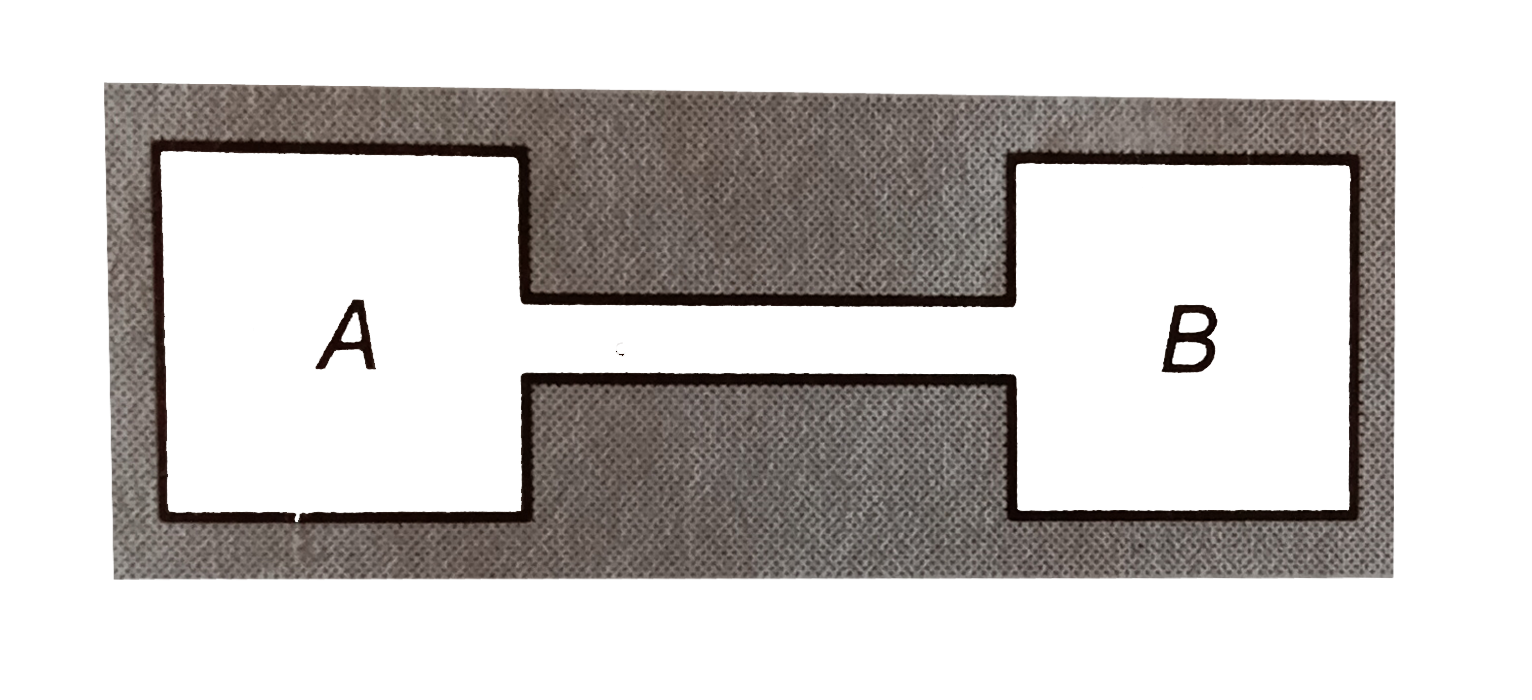 .View Solution
.View SolutionQuestion 312
An evacuated bulb of unknown volume is filled with a sample of H2 gas at a temperature T The pressure of the gas in the bulb is 756mm Hg A portion of the H2 gas is transferred to a different flask and found to occupy a volume of 40.0mL at 1.00 atn and the same temperature T The pressure of the H2 gas remaining in the original bulb drops to 625mm hg at the same temperature T Assuming H2 is an ideal gas, what is the volume of the bulb ? .View SolutionQuestion 313
Two flasks of equal volume connected by a narrow tube (of negligible volume) are at 27∘C and contain 0.70 mole of H2 to 0.5atm One of the flask is then immersed into a bath kept at 127∘C while the other remains at 27∘C Calculate the final pressure and the number of mole of H2 in each flask .View SolutionQuestion 318
A2 litre vessel is filled with air at 50∘C and pressure of 3 atm. The temperature is now raised to 200∘C A valve is now opened so that the pressure inside drops to one atm What fraction of the total number of moles, inside escaped on openig the valve ? Assume no change in the volume of the container .View SolutionQuestion 319
In a basal metabolism measurements timed at 6.0 minute a patient exhaled 52.5 litre of air measured over water at 20∘C The vapour pressure of water at 20∘C is 17.5 torr The barometric pressure was 750 torr. The exhaled air analysed 16.75 volume per cent of oxygen both on a dry basis Neglecting any solubility f the gases in water and any difference in the total volume of inhaled and exhaled air, calculate rate of oxygen consumption by the patient in mL (STP) per minute View SolutionQuestion 324
A closed container of volume 0.02m3 contains a mixture of neon and argon gases at a temperature 27∘C and pressure 1×105Nm−1 The total mass is 28 and the molar mass of and argon are 20 and 40 respectively find the masses of individual gases in the container assuming then to be ideal .View SolutionQuestion 326
A tightly sealed 25.0 litre acetone drum was found to have 15.4 litre acetone (l) at 780mm hg pressure and 18∘C Sudddenly during transportaion the drum was dented and its internal volume was found th decrease by 4.6 litre If vapour pressure of acetone at 18∘C is 400mm of Hg calculate the pressure inside the drum after denting .View SolutionQuestion 327
100g of an ideal gas (m01 wt 40) is pressent in a cylinder at 27∘C and 2 atm pressure During transportation cylinder The valve attached to cylinder cannot keep the pressure greater than 2 atm and therefore 10g of gas leaked out through cylinder Calculate
(i) the volme of cylinder before and after dent
(ii) the pressure inside the cylinder .View SolutionQuestion 328
The vapour pressure of water at 80∘C is 355 torr A 100mL vessel contained water saturated oxygen at 80∘C the total gas prssure being 760 torr The contnets of the vessel were pumped into a 50.0mL vessel at the same temperature What were the partial prssures of oxygen and water vapour waht was the total pressures of oxygen and water vapour waht was the total pressure in the first equilibarated state Neglect volume of any water which might condense .View SolutionQuestion 329
A certain container has 5×1023 molecules of a gas A at a pressure of 900 torr By a photo -chemical combination allowing light to fall on the molecules the pressure drops to 500 torr due to dimerization If the temperature and volume remain the same how many monomer dimer and total molecules are present after exposure to light ? .View SolutionQuestion 330
A container holds 3 liter of N2(g) and H2O(l) at 29∘C The prssure is found to be 1 atm The water in container is instantaneously electrolysed to give H2 and O2 following the reaction H2Ol→H2(g)+12O2g At the end of electrolysis the pressure was found to be 1.86atm calculate the amount of water present in the container If the aqueous tension of water at 29∘C is 0.04atm .View SolutionQuestion 331
Certain thin walled glass bottles generally withstand a pressure difference across their walls of 1.25 atm before they bursts A typical such bottlle is sealed on a day when the temperature is 68∘ F and the pressure is 0.08atm and it is immediately heated in an oven Estimate the temperature in degress fahrenheit at which it will explode .View SolutionQuestion 334
A compound exists in the gaseous phase both as monomer (A) and dimer (A2) The mo1 wt of A is 48 In an experiment 96g of compound was confined in a container of volume 33.6 litre and heated to 273∘C Calulate the pressure developed if the compound exists as dimer to the extent of 50% by weight under these conditions .View SolutionQuestion 337
Three hollow metallic boxes A,B and C are connected to one another through narrow tube of negligible volume and are filled with argon gas if the internal volume of these boxes are in the ratio 1:2:4 find out
The molar ratio of orgon in these boxes
(b) The mole ratio of argon if boxes A,B and C are immersed in differnet temperatures bath having 27∘C,127∘C and 327∘C respectively .View SolutionQuestion 338
A 10cm column of air is trapped by a colume of Hg 8cm long is capillary tube horizontally fixed as shown below at 1atm pressure Calculate the length of air column when the tube is fixed at same temperature
(a) Vertically with open end up
(b) Vertically with open end down
(c ) At 45∘ from horizontal with open end up .
 View Solution
View SolutionQuestion 339
A vertical hollow cylinder of height 1.52m is fitted with a movable piston of negligible mass and thickness. The lower half of the cylinder contains an ideal gas and the upper half of the mercury comes out of the cylinder Find the temperature assuming the thermal expansion of mercury to be negligible .View SolutionQuestion 341
A closed bulb cotains 0.01 mole of inert helium gas and a sample of solid white NH4CI The pressure of the he is measured at 27∘C and is found to be 114 mm Hg The bulb is then heated to 327∘C All the NH4CI decomposes according to the equation
NH4CI(s)→NH3g+HCI(g)
The final total pressure in the bulb after complete decomposition of solid is 908mm Hg Assume all the gases are ideal
(a) What is the partial pressure of HCI(g) in the bulb at 327∘C when reaction is complete
(b) How many grams of NH4CI(s) were in the bulb at 27∘C ? .View SolutionQuestion 347
The prssure in bulb dropped from 2000 to 1500 mm of Hg in 47 minutes when the contained O2 leaked through a small hole. The bulb was then completely evacuated A mixture of O2 and another gas of mol wt 79 in the molar ratio 1:1 at a total pressure of 4000 mm of Hg was introduced Find the mole ratio of two gases remaining in the bulb after a period of 74 minutes .View SolutionQuestion 349
It has been considered that during the formatio of earth H2gas was available on our planet Due to excessively high temperature during the formation of earth H2 gas escaped out of the planet If average escaping velocity of H2 is 1.1×106cm/sec what was the temperature at the time of earth formation ? .View SolutionQuestion 352
A 100mL mixture containing 72% of CH4 by volume and the rest an unknown gas 'X' was kept in a vessel Due to a very fin e crack the mixture effused out 21mL of the mixture was lost and the remaining mixture contained 68.35% of methane by volume Calculate molecular mass of gas X All the measurement are made at same temperature and pressure .View Solution
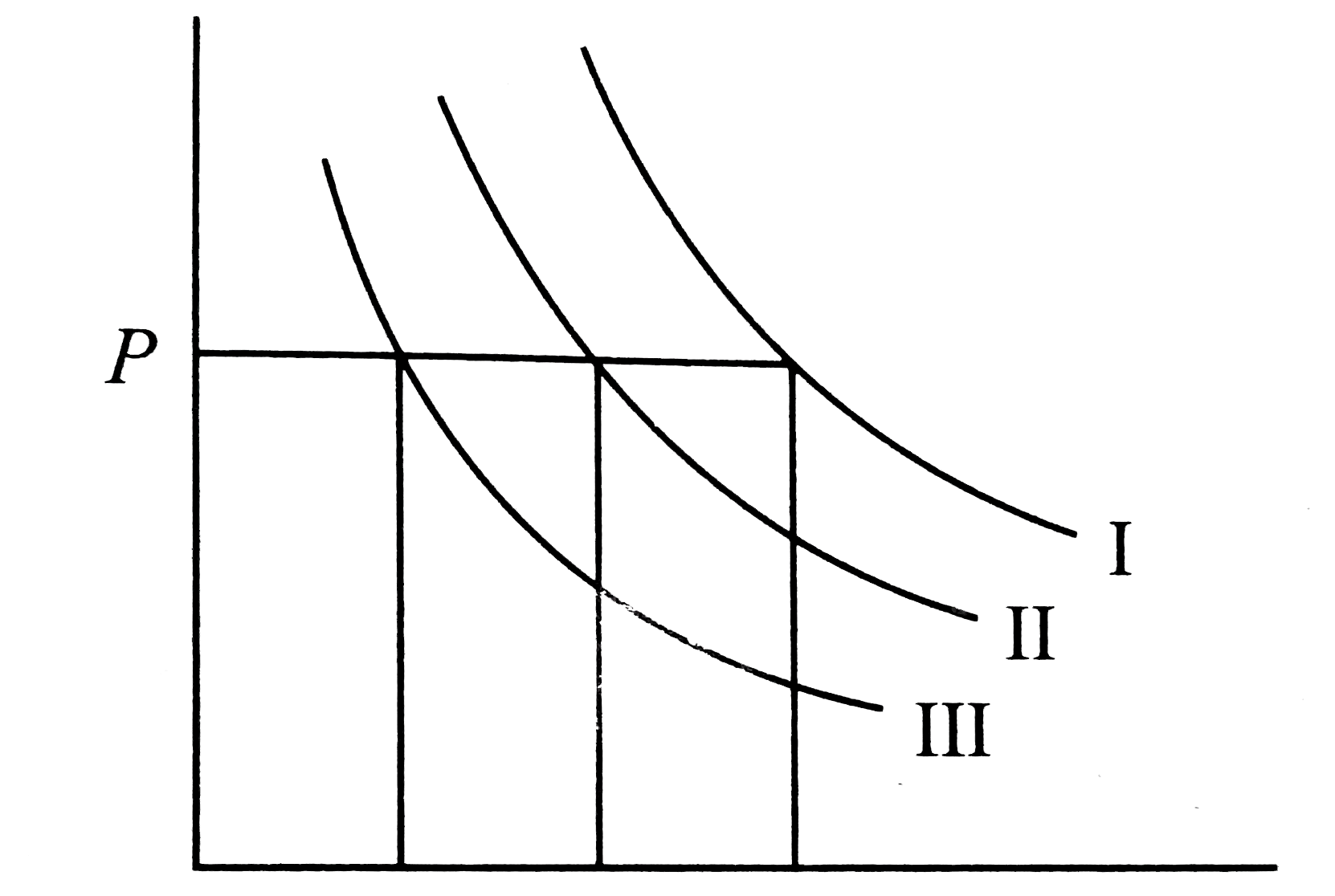
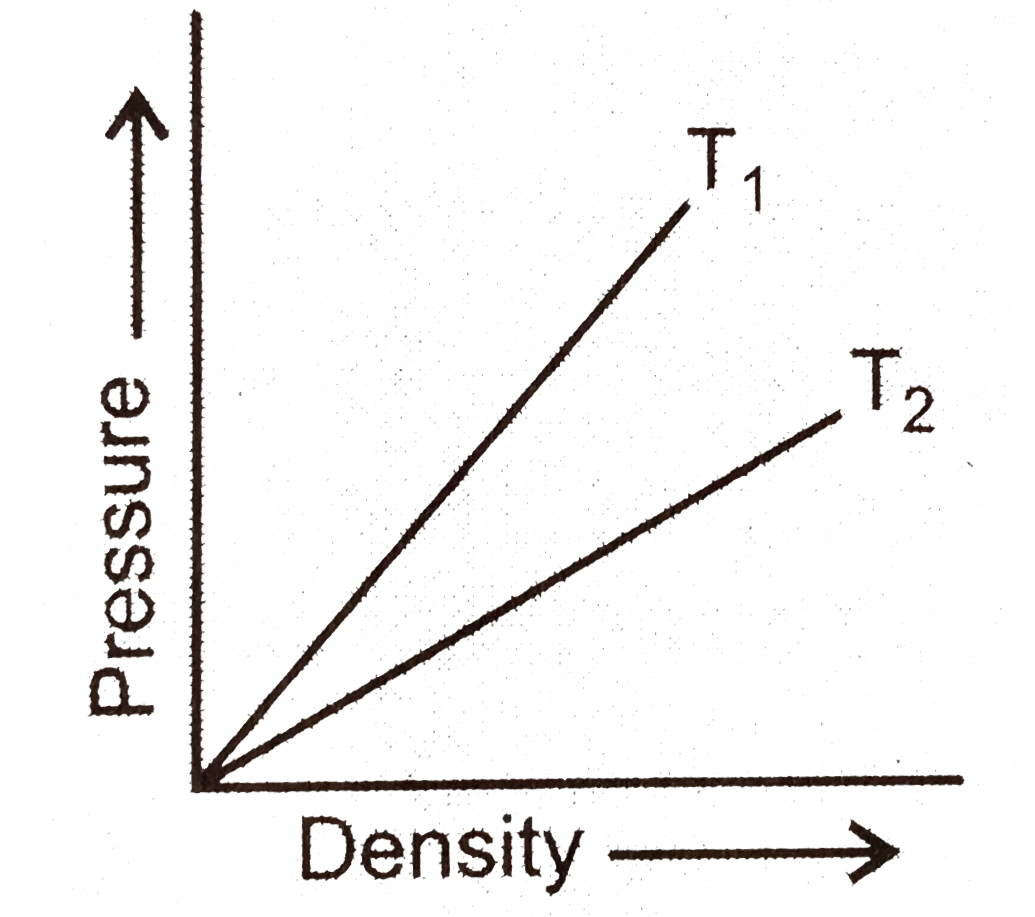 .
.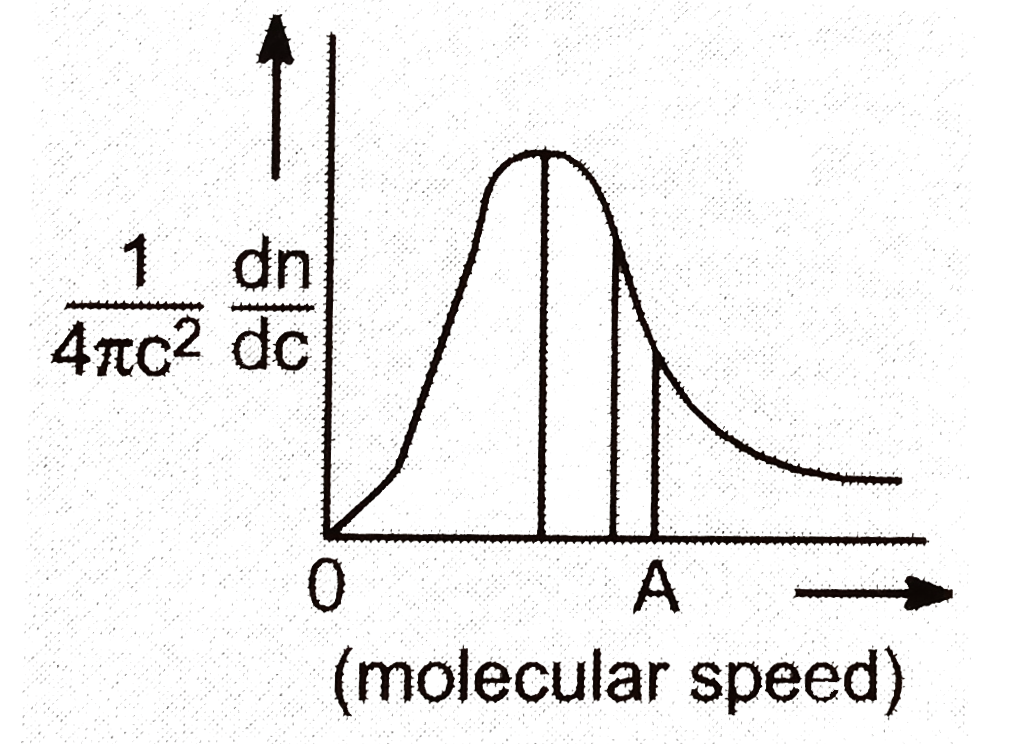 The curve has which of the following characteristics ?.
The curve has which of the following characteristics ?.
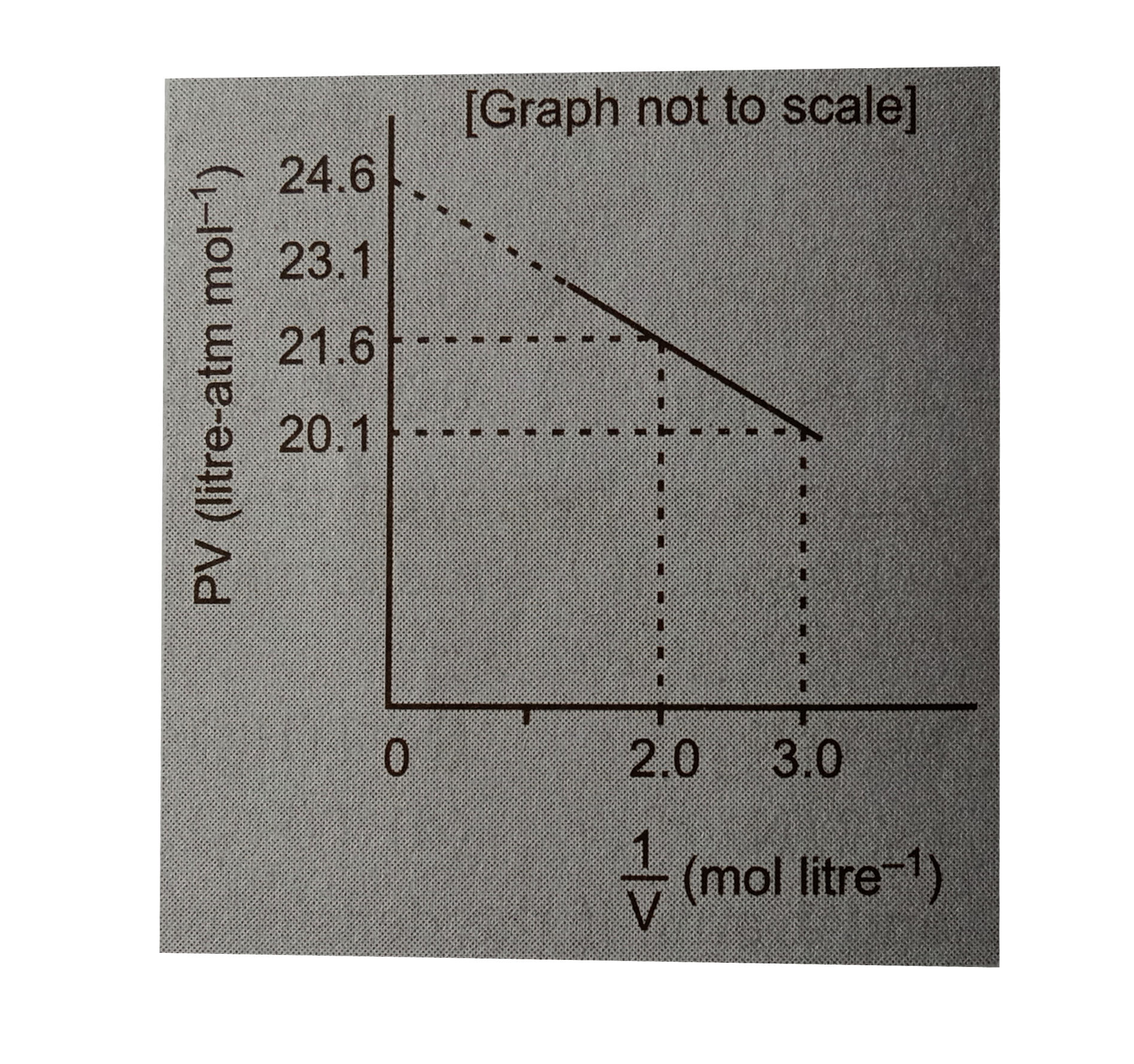 .
.